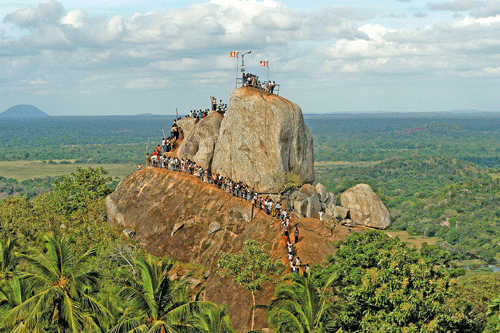A Poson Poya that changed our culture
 It may be said that the Poson Full Moon Poya is one of the most important poyas for Sri Lankans. It was on a Poson Poya that Arahant Mahinda Thera visited the island and established the Buddha Dhamma during the reign of King Devanampiyatissa, which changed the whole history of the island.
It may be said that the Poson Full Moon Poya is one of the most important poyas for Sri Lankans. It was on a Poson Poya that Arahant Mahinda Thera visited the island and established the Buddha Dhamma during the reign of King Devanampiyatissa, which changed the whole history of the island.
After the third Buddhist Council (Council of Bhikkhus), Emperor Ashoka of India decided to send emissaries to nine countries with the message of the Buddha Dhamma. He selected his son Arahant Mahinda Thera to be sent to Lanka. Arahant Mahinda however realised that it was not the ideal time to visit the island, as King Mutasiva, the Lankan monarch was advanced in age and would find it difficult to understand the profound Dhamma of the Buddha.
Arahant Mahinda and his entourage visited his mother Devi in the village of Vedisigiri to bide their time until a younger king ascended the throne. After six months King Mutasiva passed away and his son Tissa became king. Arahant Mahinda Thera with four bhikkhus – Itthiya, Uttiya, Sambala, Buddhasala, Sumana samanera (novice monk), and upasaka Bhanduka - a layman, arrived at the Missaka rock (Mihintale), close to the ancient capital of Anuradhapura on a Poson Poya.
It was a festive day in the island and the king was on a hunting expedition. Chasing a deer, he had lost his way and arrived at the foot of the Missaka rock (Mihintale). Surprised to hear his name Tissa being called, he stopped near a mango tree and looked up to see a strange group standing on the rock, five in yellow robes.
The Arahant Thera wished to test the king’s intelligence and posed two questions in the form of riddles. One was about a mango tree. The king answered intelligently and the Arahant knew that he would be able to comprehend the Buddha Dhamma. He delivered the Chullahattipadopama Sutta to the king and explained that it is about the Buddha, Dhamma and Sangha and to live as a disciplined monk and the path to Nibbana which is the ultimate goal of a Buddhist. The king and his 40,000 people embraced Buddhism, moving away from the earlier worship of trees and rocks.
On that day the layman Upasaka Bhanduka was ordained. It was the first ordination in the island by the Arahant Thera, as the required number of five monks (including himself) were present to conduct the ordination. Thereafter Arahant Mahinda lived in Anuradhapura for a short time and left to Mihintale where he established the Buddha’s teachings in the island. The king cleared many caves in the area for the bhikkhus to sit in meditation and achieve their goal.
Mahinda Thera who had come to the island at the age of 32 passed away aged 80 years. The Mihindu Maha Seya in Mihintale is built in his memory and people travel there from all parts of the island mainly on Poson Poya to venerate the Arahant.
With the arrival of Arahant Mahinda, a cultural revolution took place. Buddhist cultural practices prevailed in the island. There was development in art, literature, writing and sculpture. Carvings on rocks, paintings and writings are seen even today making us admire the work of our ancient craftsmen and wonder what tools they would have used for those creations.
The large chaityas or dagabas/seyas across the country are works of great skill. Made of brick using special materials and the technology of ancient times, the dagabas are differently shaped – we can identify the Bubulakara (bubble shape), Dhanyakara (shaped like a heap of paddy), Ghantakara (bell shaped), Ghatakara (pot shaped) and Padmakara (lotus shape). There are also two other rare shapes – the Amlakara (shape of a Nelli fruit) and Palandawakara (shape of an onion).
At the request of Arahant Mahinda, King Devanampiyatissa requested Emperor Ashoka to send the Buddha relics to Lanka. Ashoka sent the right collar bone of the Buddha which was enshrined in the Thuparama built by the King. This is believed to be the first historic stupa/chaitya built in Sri Lanka. Later King Dutugemunu built many dagabas. In the Ruwanweli Maha Seya a drona of the Buddha relics are enshrined, revered by Buddhist devotees. Ancient kings built these stupas believing it to be a meritorious act.
A stupa/dagaba/chaitya usually has six parts and other structures as protection chambers: Pesavalalu, gharbaya (a hemispherical dome), Hathareskotuwa, Devathakotuwa, Kothkerella and Kotha. The Kotha is usually a pinnacle made of metal. A precious crystal or gemstone is placed on top of it.
Although the Buddha visited Sri Lanka on three occasions, the Buddha Dhamma was established in the island only after the visit of Arahant Mahinda Maha Thera on a Poson poya.
Arahant Mahinda Maha Thera’s visit also paved the way for his sister Arahant Sangamitta Theri to come to Lanka with a sapling of the Sri Maha Bodhi to establish the Meheni Sasana, the order of nuns.
Searching for an ideal partner? Find your soul mate on Hitad.lk, Sri Lanka's favourite marriage proposals page. With Hitad.lk matrimonial advertisements you have access to thousands of ads from potential suitors who are looking for someone just like you.


